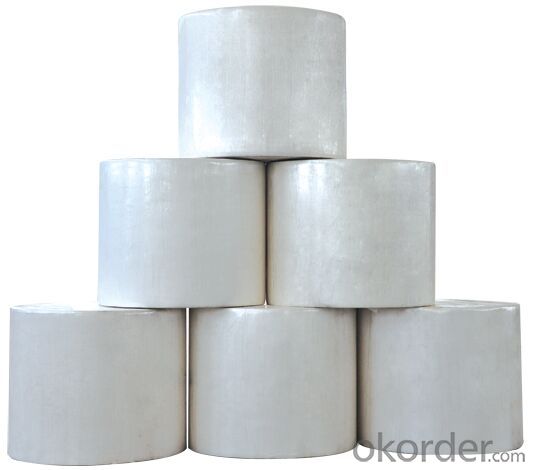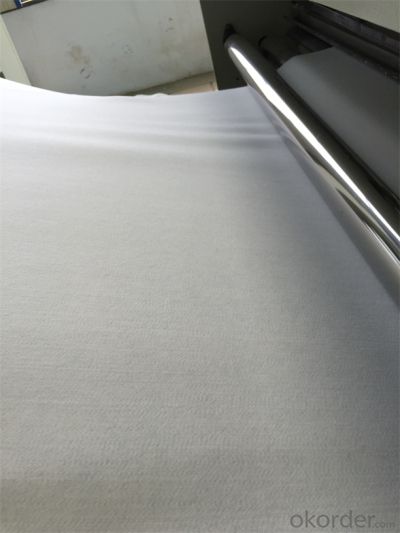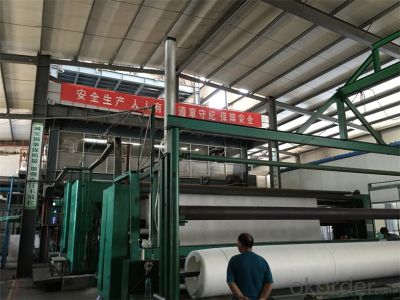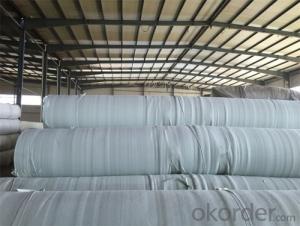Geotextile Continuous Filament Spunbonded Nonwoven Style
- Loading Port:
- Qingdao
- Payment Terms:
- TT or LC
- Min Order Qty:
- 2000 m²
- Supply Capability:
- 800000 m²/month
OKorder Service Pledge
OKorder Financial Service
You Might Also Like
Continuous Filament Spunbonded Nonwoven Geotextile
Introdcution of Continuous Filament Spunbonded Nonwoven Geotextile:
Made from virgin PET (polyester) chips, the continuous filament was extruded from PET chip by machine directly by spunbond process, and then punch together to get the stable 3D with higher strength fabric. So it has high strength, good creep property excellent and erosion resistance, aging-resistance and heat resistance.
Specifications of Continuous Filament Spunbonded Nonwoven Geotextile:
•100g/m2—800g/ m2
•4m—7m in roll width
the length as clients’ request
Production Standard:
GB/T17638-1998
Jt/t 520-2004
Advantage of Continuous Filament Spunbonded Nonwoven Geotextile:
Good creep property and hydraulics property, resistance to corrosion, excellent anti-aging and heat-resistance quality.
Applications of Continuous Filament Spunbonded Nonwoven Geotextile:
• Filtration of soils in drainage applications by retaining soil particles while allowing for the free flow of water.
•Separation and stabilization in road and railway construction
•Prevention of soil movement in erosion control measures
•Cushioning and protection in many containment projects
FAQ:
1. Which payment do you accept?
For you convinience,our payment can be L/C,TT
2. Is free sample available?
We can supply free samples. You'll just need to pay for express cost.
3. How about your quality?
We have strict quality control system, we make testing on incoming raw material and finished products. Your third party testing is also welcomed. With high quality, our products are used on government projects at home and abroad. Our product quality is accepted by clients from all over the world.
Photos of Products and Factory:





- Q:How do geotextiles improve the performance of geosynthetic clay liners?
- Geotextiles improve the performance of geosynthetic clay liners by providing additional reinforcement and filtration capabilities. They act as a separation layer between the clay liner and other materials, preventing the mixing of different soil layers and enhancing the liner's stability. Geotextiles also enhance the liner's filtration properties, allowing water to pass through while preventing the migration of fine particles. This improves the overall performance and longevity of geosynthetic clay liners in various engineering and environmental applications.
- Q:What are the specifications for geotextiles in retaining wall construction?
- The specifications for geotextiles in retaining wall construction typically include factors such as the tensile strength, puncture resistance, and permeability of the material. They should also meet certain standards for durability, UV resistance, and chemical compatibility with the surrounding soil. Additionally, the geotextiles should have appropriate dimensions and weight to provide effective separation, filtration, and reinforcement within the retaining wall system.
- Q:How do geotextiles contribute to soil moisture retention?
- Geotextiles contribute to soil moisture retention by acting as a barrier that prevents water evaporation from the soil surface. They also help in distributing water evenly throughout the soil profile by reducing the rate of infiltration and promoting slow water percolation. Additionally, geotextiles can prevent soil erosion, which can lead to the loss of moisture from the soil. Overall, geotextiles play a crucial role in retaining soil moisture and promoting healthy plant growth.
- Q:Are geotextiles resistant to hydrostatic pressure?
- Yes, geotextiles are generally resistant to hydrostatic pressure. They are designed to have high tensile strength and durability, which allows them to withstand the pressure exerted by liquids or water.
- Q:Can geotextiles be used in the protection of underground cables and pipes?
- Yes, geotextiles can be used in the protection of underground cables and pipes. Geotextiles act as a barrier between the cables/pipes and surrounding soil, preventing potential damage caused by abrasion, puncture, or chemical reactions. They help distribute loads and provide stability, improving the overall performance and lifespan of underground infrastructure.
- Q:Can geotextiles be used in green roof applications?
- Yes, geotextiles can be used in green roof applications. Geotextiles are often used as a protective barrier or filter layer in green roofs to prevent soil erosion and aid in drainage. They can help retain moisture and provide stability to the growing medium, promoting healthy plant growth on green roofs.
- Q:What are the specifications for geotextiles and geogrids commonly used on expressways?
- You are the production, or sales, or procurement, the question asked, what model is the designer's decision
- Q:How do geotextiles help in reducing soil erosion caused by wind?
- Geotextiles help in reducing soil erosion caused by wind by acting as a barrier that prevents the soil particles from being carried away. They are commonly used as a protective layer on slopes or exposed areas, where they effectively stabilize the soil and prevent it from being blown away by wind. Additionally, geotextiles also help in promoting vegetation growth by retaining moisture and providing a favorable environment for plant root development, further strengthening the soil and reducing erosion.
- Q:What is geotextile cloth?
- Geogrid, geotextile, geomembrane manufacturers, specializing in the production
- Q:Are geotextiles suitable for use in landfill caps?
- Yes, geotextiles are suitable for use in landfill caps. They are commonly used in landfill engineering to reinforce the cap system, prevent erosion, provide stability, and enhance water drainage. Geotextiles help to reduce the infiltration of rainwater, control gas emissions, and prevent the release of contaminants from the landfill. Additionally, they can enhance the overall performance and longevity of the landfill cap by providing strength and durability.
1. Manufacturer Overview |
|
|---|---|
| Location | |
| Year Established | |
| Annual Output Value | |
| Main Markets | |
| Company Certifications | |
2. Manufacturer Certificates |
|
|---|---|
| a) Certification Name | |
| Range | |
| Reference | |
| Validity Period | |
3. Manufacturer Capability |
|
|---|---|
| a)Trade Capacity | |
| Nearest Port | |
| Export Percentage | |
| No.of Employees in Trade Department | |
| Language Spoken: | |
| b)Factory Information | |
| Factory Size: | |
| No. of Production Lines | |
| Contract Manufacturing | |
| Product Price Range | |
Send your message to us
Geotextile Continuous Filament Spunbonded Nonwoven Style
- Loading Port:
- Qingdao
- Payment Terms:
- TT or LC
- Min Order Qty:
- 2000 m²
- Supply Capability:
- 800000 m²/month
OKorder Service Pledge
OKorder Financial Service
Similar products
New products
Hot products
Hot Searches
Related keywords

































